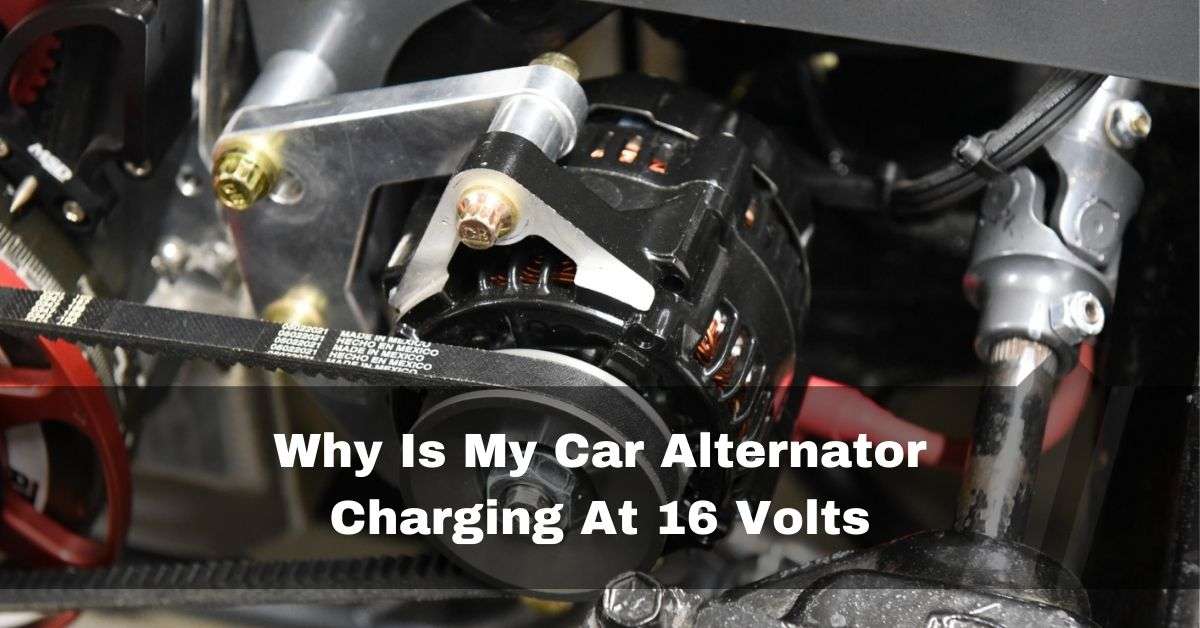To keep the battery charged and deliver power to the car’s electrical systems, an alternator usually maintains a charging voltage of about 13.5 to 14.5 volts. However, if your car’s alternator is charging at 16 volts or more, it may be a sign that something is wrong and has to be fixed.
If the battery light on the dash is on and you are measuring 16 V with the engine running, you may have a bad regulator. It would help if you verified that because it can lead to the battery overcharging.
This article will examine why a car alternator is charging at such a high voltage and potential solutions.
Table of Contents
Causes of Car Alternator Charging At 16 Volts:
1. Faulty Voltage Regulator:
The voltage regulator is an essential part of the alternator that manages the voltage output. Its main job is to keep the voltage constant within a specific range—typically between 13.5 and 14.5 volts—so that the battery can be charged properly and the car’s electrical components can be powered.

However, if the voltage regulator is damaged or fails, the alternator may produce too much voltage. When a voltage regulator malfunctions, it can no longer efficiently control its output. It may cause the alternator to continuously have a greater voltage, such as 16 volts or higher.
2. Shorted Field Circuit:
The field circuit is in charge of managing how much electricity is generated by the alternator. It comprises coils or windings that produce a magnetic field when an electrical current flows through them. Inducing an electrical charge in the stator windings, which eventually has the power produced by the alternator, depends on this magnetic field.

If the field circuit shorts out, the alternator’s regular operation will be interfered with by an unauthorized connection between various circuit components. A shorted field circuit can obstruct voltage regulation and result in the alternator producing higher voltages than are required.
3. Grounding Issues:
The practical and precise operation of the alternator depends on proper grounding. A constant voltage output is maintained, and the electrical current has a return path thanks to the grounding mechanism. However, grounding problems, such as bad connections, corrosion, or flawed grounds, might impair the alternator’s ability to regulate voltage.

The alternator may be unable to precisely measure and regulate the voltage output when it has issues with grounding. As a result, the charging voltage can increase above average and hit 16 volts or higher.
4. Wiring Problems:
The alternator system’s wiring is essential for delivering electrical current and preserving adequate voltage regulation. Electrical resistance might develop within the system if the wiring connections are broken, rusted, or loose. This resistance can obstruct electrical current and compromise the alternator’s capacity to regulate voltage precisely.

Higher charging voltages may result from uneven electrical resistance when there are wiring issues with the alternator system.
How To Fix High Charging Voltage?
1. Inspect And Replace The Voltage Regulator:
Start by looking for any damage or malfunctions with the voltage regulator. Replace it with a new one if necessary. If the regulator cannot be removed because it is frequently inside the alternator, the entire alternator may need to be replaced.

2. Check And Repair Field Circuit:
You should fix or replace the alternator if a shorted field circuit is to blame for the excessive charging voltage. A qualified mechanic can identify the problem and advise on the best action.
3. Verify Grounding Connections:
Make sure all grounding connections are tidy, safe, and linked correctly. Clean the contacts of any corrosion or rust, and tighten them as necessary. It is best to seek professional advice if your ground may need fixing.

4. Check And Repair Wiring:
Search for any indications of damage or loose connections in the wire connections surrounding the alternator. Any damaged wire should be replaced or fixed, and all links should be made firmly. It can assist in removing voltage fluctuations brought on by wiring problems.

High charging voltage needs to be addressed immediately because it can harm delicate electrical parts of your car. Long-term exposure to high voltage can also cause battery overcharging, which shortens the battery’s life.
How Do I Know If My Alternator Is Overcharging?
According to this usage, an alternator is considered “overcharging” if it provides more output than it is designed to. It necessitates a sufficient understanding because all alternators are programmed to produce work in voltage within a specific range. This range demonstrates the operational threshold within which a particular vehicle’s electronics are designed to function.
1. Irregular Dash Readings:
Reading on the voltage gauge in your vehicle’s instrument cluster that is too high is one of the most evident symptoms of alternator overcharging.

Any value above 15 volts calls for additional inquiry, but readings noticeably higher than that raise serious concerns. Certain automobiles will even display a warning message when voltage readings surpass acceptable limits.
2. Battery Abnormalities:
An overcharging alternator is most likely to blame if your car’s battery casing suddenly bulges or an under-the-hood check finds that your battery has heated up to an uncomfortable level.
Alternatively, you might also notice that the electrolyte in your battery has started to boil over or that the smell of sulfur emanates from your car’s battery.
3. Shortened Bulb Life:
The repeated need to replace a car’s headlight, fog light, or marker light bulbs may occasionally identify the alternate overcurrent. It is particularly true if the bulbs on a vehicle are blowing more regularly.

This symptom itself results from the extra strain that excess voltage introduced to a single bulb causes.
How To Reduce Alternator Output?
- Ensure the battery is ultimately charged before attempting to lower an alternator’s output on a vehicle. When the battery is ultimately charged, the alternator may work harder and generate higher output.
- A voltmeter can be used to check the battery’s charge. Before attempting to lower the alternator’s output, you should charge it if the battery is low.
- Try turning off any lights or electrical accessories that make the alternator work harder once you have ensured the battery is ultimately charged.
- Additionally, check all connections are safe and in good working order by checking them twice. You can consult a professional or the owner’s manual if you need assistance.
- Alternator replacement may be necessary if you still have difficulties lowering the alternator’s output.
The mechanic, Pearl Wilson, advises locating a replacement alternator made specifically for the make and model of your car. It will guarantee that your engine and the new alternator are compatible and that no issues will arise.
FAQs:
1. What Happens If The Alternator Is Overcharging?
An overcharging alternator can quickly ruin sensitive electrical components, making them useless. It ultimately necessitates costly repairs that are substantially more expensive than simply purchasing a new alternator to address the issue.
2. What Are The Symptoms Of an Overloaded Alternator?
An overloaded alternator tries to push too much current through its wires, overheating and dangerously raising its temperature. In addition to creating resistance to power flow, damaged wires often heat up and smell bad.
3. What Would Cause An Alternator To Put Out Too Much Voltage?
The output ratings and designs of specific replacement and remanufactured alternators are significantly more excellent. The charging supply will be greater than the demand, resulting in an overcharged state when the nasty alternator has been fitted in a standard car or if the pulley has inadequate dimensions (producing additional alternator spin).
Conclusion:
The voltage regulator, field circuit, grounding connections, or wiring may all be at fault if your car alternator is charging at 16 volts or more. By looking over and fixing these components, you may set the issue and ensure your car’s electrical system performs within the typical voltage range. Remember, it’s always preferable to get professional assistance if you need clarification on any part of the diagnosis or repair.

